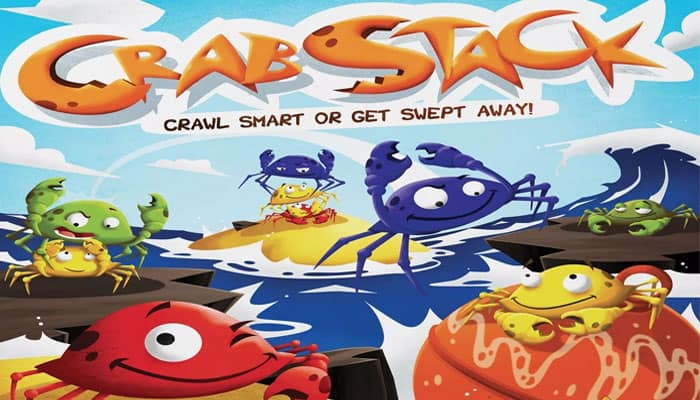
The tide is rising, and the waves are growing stronger, so gather your fellow crabs together! Crawl smart to trap your opponents beneath you, and make sure the waves don't wash you out to sea!

Components
- 1 Hexagonal gameboard
- 36 wooden crab tokens
- Rulebook
Object of the Game
Immobilize your opponents' crabs by landing on top of them, or wash them away using the Wave Rule.
The last player still able to move at least one of his crabs wins the game.
Setup
Each player chooses a color of crab tokens to play with. Then, all of the crabs of the chosen colors are shuffled together and randomly distributed (one in each space), according to the following illustrations.

Determine a starting player in any way you want. Now the game can begin. Play proceeds in clockwise order.
Game Play
On your turn, you have to move one of your crabs according to the rules for Moving Crabs.
Moving Crabs

Crabs move a different number of adjacent spaces depending on their size:
- Large crabs must move 1 space.
- Medium crabs must move 2 spaces.
- Small crabs must move 3 spaces.
Crabs can crawl over any other crab, but must end their move on top of a crab that is their size or smaller: • Large crabs can end their turn on any crab.
- Medium crabs can end their turn only on medium or small crabs.
- Small crabs can only end their turn on small crabs.
Important:
Crabs cannot backtrack over the same spot in one turn.
Crabs cannot move over open water.
Crabs must always end their move on top of other crabs, never on an empty space.
Only the topmost crab can move; any crabs beneath it are trapped until they are uncovered.
After the current player moves one of his crabs, the next player takes his turn.
The Wave Rule

Crabs must remain connected to each other in one group of crabs. If the crabs are ever divided into two separate groups of crabs, then the smaller group is washed away and removed from the board for the rest of the game.
To determine which group of crabs is smaller, first look at the number of spaces occupied. The group with the fewer spaces is washed away.
If there is a tie for number of spaces occupied, then count how many individual crabs are in each group; the group with fewer crabs is washed away.
If there is still a tie, then the player whose turn it is chooses which group of crabs is washed away.
Example: The movement of one of the crabs has created two groups of crabs. The upper group occupies 23 spaces and the group at the bottom only 5 spaces. Consequently, the group at the bottom is removed
End of the Game
When a player can no longer move any of his crabs, he is eliminated from the game. A
ny of his crabs still left on the gameboard remain where they are, but can no longer be moved for the rest of the game (even if they are uncovered on later turns).
Once all players, except for one, have been eliminated, the remaining player wins the game.
Stalemate
If players find themselves repeating the same moves without getting f any closer to finishing the . game, you should declare a draw and start a new game to determine a winner.
Continue Reading

